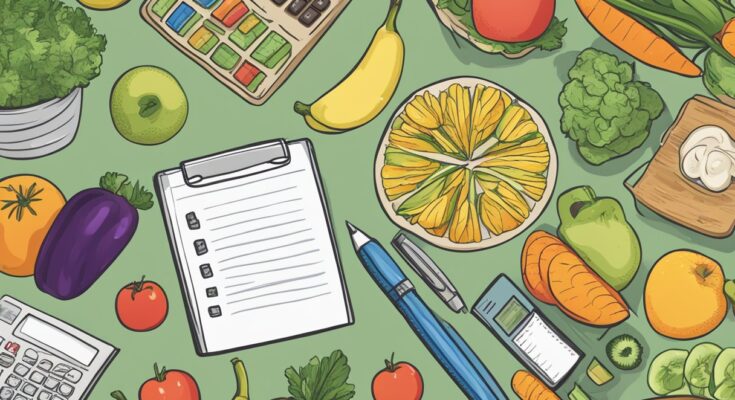Navigating the supermarket aisles while keeping your wallet intact can be a challenging task. Understanding how to compile a grocery list that suits your budget without compromising on quality or nutrition is a valuable skill. Careful planning and strategic shopping can significantly reduce your grocery expenses.
Creating a well-thought-out list is the first step towards smarter grocery shopping. Prioritizing essential items and being creative with meal planning helps ensure you meet your nutritional needs without overspending. By focusing on discounts, buying in bulk when necessary, and avoiding impulse buys, you can manage your grocery spending more effectively.
Each trip to the grocery store is an opportunity to refine your budgeting skills. Learn to store and preserve food correctly to extend its lifespan. Making use of available resources and tools can streamline this process, allowing you to make informed decisions every time you shop.
Table of contents
Key Takeaways
- Create a strategic grocery list to control spending.
- Prioritize nutrition without overspending.
- Use tools to make informed grocery decisions.
Understanding Grocery Budgeting
Creating an effective grocery budget involves knowing how much you can spend and understanding the economics behind food shopping. By planning wisely, you can maximize savings and reduce waste.
Determining Your Budget
Start by assessing your monthly income and essential expenses. Identify how much is left for groceries. Consider creating a weekly budget as it is often easier to manage short-term financial goals. Use a budget planner or an app to track your spending pattern.
Evaluate family size and dietary needs. A larger family may require a larger budget, but buying in bulk can help balance costs. Be mindful of dietary restrictions or preferences that may affect price, such as organic or specialty items.
The Economics of Food Shopping
Understand the factors affecting food prices, including seasonality and location. For example, fruits and vegetables are often less expensive when purchased in season. Explore options like local farmers’ markets to find fresh, cheap produce.
Store brands tend to be cheaper without sacrificing quality. Always compare prices per unit, which you can find on shelf labels, to get the best deal. Use coupons and loyalty programs offered by grocery stores to further cut costs.
Plan your meals around weekly supermarket specials and discounts. Sticking to a shopping list reduces impulse purchases and helps you stay within your budget.
Strategies for Saving Money
Saving money on groceries requires effective planning and informed purchasing decisions. By focusing on seasonal options, using available discounts, and being smart about purchase sizes, you can manage your grocery budget more efficiently.
Seasonal Purchases
Purchasing fruits and vegetables that are in-season can significantly cut costs. Seasonal produce is often more abundant and thus cheaper due to supply. For example, berries in the summer and squash in the fall tend to be more affordable.
Fresher options also mean better taste and quality. Create meal plans based on seasonal items. This approach can encourage variety in your meals and keep your diet balanced while saving money. You can also freeze or preserve excess produce for future use.
Coupon and Discount Utilization
Take advantage of coupons and discounts offered by grocery stores. Many stores provide loyalty apps that feature exclusive deals. Signing up for these apps can ensure you never miss a discount.
Keep an eye on weekly flyers both in print and online. Combine coupons with sales for maximum savings. Organizing your coupons by category can help simplify the shopping process. Additionally, look for digital coupons that can be scanned directly from your smartphone.
Bulk Buying Benefits
Buying certain products in bulk can provide significant savings. Non-perishable items like canned goods, grains, and toiletries are ideal for bulk purchases. Membership warehouses often offer lower prices per unit for larger quantities.
Consider sharing bulk purchases with family or friends if storage space is an issue. Use price-per-unit calculations to identify cost-effective options. Remember, it is essential to ensure that these items will be used before their expiration dates to truly save money.
Loyalty Programs and Rewards
Enroll in store loyalty programs to make the most of your purchasing power. Many stores offer rewards in the form of discounts, points, or cashback. These programs often provide tailored deals based on your shopping habits.
Keep track of your points and their expiration. Redeem them for discounts on future purchases. Studying the details of each program will help you find the most valuable ones for your buying habits. Utilizing these rewards can lead to considerable savings over time.
Planning Your Grocery Trips
Having a well-organized strategy for your grocery shopping can save both time and money. Focus on creating a shopping list, planning your meals, and staying away from impulse buys.
The Importance of a Shopping List
A shopping list is crucial when you’re grocery shopping on a budget. It helps you focus on essentials and prevents unnecessary purchases. Start by listing down items you need based on your regular meals and household needs. Categorize items into sections like produce, dairy, and grains. This makes navigating the store quicker and reduces the temptation to divert from the list.
An organized list allows you to better anticipate spending. Review weekly store promotions and coupons to see if any align with your list. This can potentially lower your total expenses. By sticking to the list, you’ll find it easier to resist the allure of non-essential items.
Meal Planning 101
Meal planning involves preparing a strategic menu for the week that utilizes key ingredients efficiently. Choose recipes that share similar components to maximize the use of each purchased item. Plan breakfasts, lunches, and dinners in advance, ensuring variety while keeping costs low. Consider meals that use seasonal produce, as these are often more affordable.
Flexibility is key. Have a couple of backup meals that require non-perishable items or ingredients you already have in your pantry. This helps when plans change unexpectedly. Meal planning also reduces waste, as ingredients are used up within a planned schedule, minimizing spoilage. This is a key when you are also wondering how to stock your fridge on a budget.
Avoiding Impulse Purchases
Impulse buys can easily wreak havoc on a grocery budget. These are often items you didn’t originally plan on buying. Awareness is pivotal. Stores are designed to tempt shoppers, placing enticing buys along the aisles and checkout lines. Try shopping after a meal to avoid hunger-driven purchases.
Create rules for yourself. Limit how many non-list items you can buy in a given trip or bring only a set amount of cash to enforce budgetary discipline. Evaluate why the product interests you and if it genuinely adds value to your plan. Often, after a moment of consideration, you may find it unnecessary.
Nutrition on a Budget
When groceries are chosen wisely, achieving a healthy diet doesn’t have to break the bank. Focusing on whole foods, selecting cost-effective healthy options, and reading food labels carefully can make all the difference.
Shopping for Whole Foods
Buying whole foods rather than processed items is often more economical and healthier. Instead of purchasing pre-cut vegetables or prepared meals, consider buying fresh, seasonal produce. Whole grains such as rice or oats can be a staple to provide energy and nutrients at a lower cost. Tip: Bulk buying can reduce costs further, especially for pantry staples like beans or nuts.
Cost-Effective Healthy Options
Certain foods deliver nutrients without a hefty price tag. Legumes, such as lentils or chickpeas, offer protein and fiber and can replace more expensive meats. Eggs are a versatile, nutrient-rich protein source. A list highlighting low-cost, nutritious foods might include:
- Sweet potatoes
- Cabbage
- Bananas
Opt for these to maximize your grocery budget while prioritizing health.
Understanding Food Labels
Reading food labels can help you make better nutritional decisions without overspending. Pay close attention to the ingredient list and nutritional facts panel. Look for products with fewer additives and preservatives. Aim for items with high nutritional value per serving, like protein or fiber content. By deciphering serving sizes and the percentage of daily values, you can choose the most nutritious options available, staying within budget.
Shopping Tactics
Achieving a budget-friendly grocery list requires strategic shopping practices. Understanding the balance between store brands and name brands, knowing how to read unit prices effectively, and taking advantage of sales cycles can help manage your expenses.
Store Brand vs. Name Brand
Choosing between store brands and name brands can impact your budget significantly. Store brands often cost less while providing similar quality. Review labels to compare ingredients and nutritional information, as some store brands offer comparable or even better quality.
Know when it’s worth spending extra on name brands. Items like peanut butter or coffee might have a noticeable taste or quality difference. Conduct taste tests on your staple items to see if the difference matters to you. Also, check for sales on name brands, as these can offer competitive prices.
Reading Unit Prices
Unit pricing is a valuable tool for budget-conscious shopping. It provides the cost per unit (e.g., per ounce or per pound), helping you compare prices between different brands and package sizes. Always check the unit price on the shelf tag to determine the best buy.
Smaller packages often seem cheaper, but larger sizes could offer better value. Use a calculator if needed to ensure accuracy. Additionally, be mindful of packaging tricks, where the same product is packaged differently to obscure unit pricing clarity.
Navigating Sales Cycles
Sales cycles can significantly reduce your grocery bill. Most stores have regular sales periods for different product categories, typically every 6-12 weeks. Understand these cycles to stock up when items are at their lowest prices, this way it’s much easier to make a grocery list on a budget.
Write down or use a spreadsheet to track when items go on sale. Coupons and loyalty programs further reduce costs, offering discounts and rebates. Combining sales with these offers maximizes savings. Always stay within your budget and avoid purchasing unnecessary sale items.
Storing and Preserving Food
Properly storing and preserving food helps extend shelf life and reduce waste. Key techniques include using appropriate containers, maintaining the right temperatures, and utilizing methods like freezing and canning. Effective strategies can help you maximize the use of your groceries.
Proper Food Storage Techniques
To keep your groceries fresh longer, use airtight containers to protect against air and moisture. Glass and plastic containers each have benefits; choose based on food type and storage duration. Refrigeration helps extend the life of perishable items like fruits, vegetables, and dairy. Use the crisper drawers for vegetables, maintaining optimal humidity levels to prevent wilting.
Labeling items with dates ensures you know their freshness timeline. Dry goods such as rice, pasta, and beans stay safe and usable for months when stored in cool, dry places. Make sure your pantry is organized to prevent overlooked items from expiring or spoiling.
Freezing and Canning Basics
Freezing helps maintain nutritional value for months. Before freezing, remove as much air as possible from containers or bags to reduce freezer burn. Blanching vegetables before freezing can preserve their color and nutrients.
For canning, clean jars thoroughly, and fill them with prepared food, leaving enough headspace. Water bath canning suits high-acid foods such as fruits, while pressure canning is necessary for low-acid foods like meats and vegetables. This method prevents the growth of harmful bacteria.
Reducing Food Waste
Reducing food waste starts with planning. Organize your shopping to avoid over-purchasing. Using leftovers creatively can also limit waste. Soups, stews, and salads offer flexibility for using surplus ingredients.
Compost inedible scraps to contribute to soil health instead of landfills. Being mindful of expiration dates and storage methods ensures you consume groceries before they spoil. Regularly cleaning your fridge can help you spot items that need to be eaten sooner, reducing forgotten perishables.
Resources and Tools
Managing your grocery shopping on a budget involves leveraging practical resources and tools. Budget-friendly recipes can stretch your ingredients further. Grocery list apps help track spending, and online deal trackers ensure you catch the best deals.
Budget-Friendly Recipes
Affordable meals are vital for cost-effective grocery shopping. Focus on recipes that use staple ingredients like rice, beans, and seasonal produce. Chili, pasta, and stir-fry dishes can be made with inexpensive ingredients.
Look for recipe websites and blogs dedicated to budget cooking. They offer ideas that incorporate bulk items or leftovers. Meal planning helps prevent unnecessary purchases, saving both time and money. Choose recipes with fewer ingredients and ones that align with your dietary needs.
Grocery List Apps
Using grocery list apps helps manage your on a budget shopping better. Apps like AnyList, Out of Milk, and Listonic offer features that keep you organized. These apps let you categorize items, compare prices, and track your spending.
Some apps have sharing options, making it easy to coordinate with family. Apps often include barcode scanners, so you can quickly add items. Choose an app that fits your shopping habits, whether that’s syncing across devices or integrating with meal planning.
Online Deal Trackers
Tracking discounts and deals can significantly cut your grocery bill. Websites like Honey and Rakuten provide insights into available discounts and cashback offers. They help you identify which stores have the best deals on the products you frequently buy.
Sign up for alert services that notify you of price drops. Coupons and cashback rewards expand savings further. This strategy requires just a little planning ahead but can lead to significant cost savings over time.
By using these tools, you can make savvy decisions each time you shop.
Summary
Grocery list on a budget involves planning and prioritizing. By focusing on cost-effective meal planning, you can maintain a healthy diet without overspending. Pay attention to any coupons or discount you can get from stores near you. Do not go to shopping with your belly empty to avoid unnecessary shopping. Now it’s time to follow this tips to save money on your next grocery shopping.
Frequently Asked Questions
Include nutrient-dense foods like beans, rice, and fresh vegetables. Purchase frozen fruits and veggies as affordable alternatives to fresh ones. Reduce meat consumption by focusing on plant-based meals. Monitor portion sizes to make ingredients last.
A reasonable budget for one person is typically $50-$75 per week. This varies depending on dietary needs and location. Regularly review spending to adjust your budget as needed to match fluctuating grocery prices.
Share meals to reduce costs by cooking in larger batches. Plan balanced meals around shared ingredients to minimize waste. Incorporate affordable protein sources like eggs and lentils. Coordinate meal plans to align with sales and available discounts.
Purchase non-perishable items during sales and use coupons. Buy larger quantities of items with long shelf lives. Consider joining a wholesale club for discounts on bulk products. Preserve seasonal produce by freezing or canning them.




